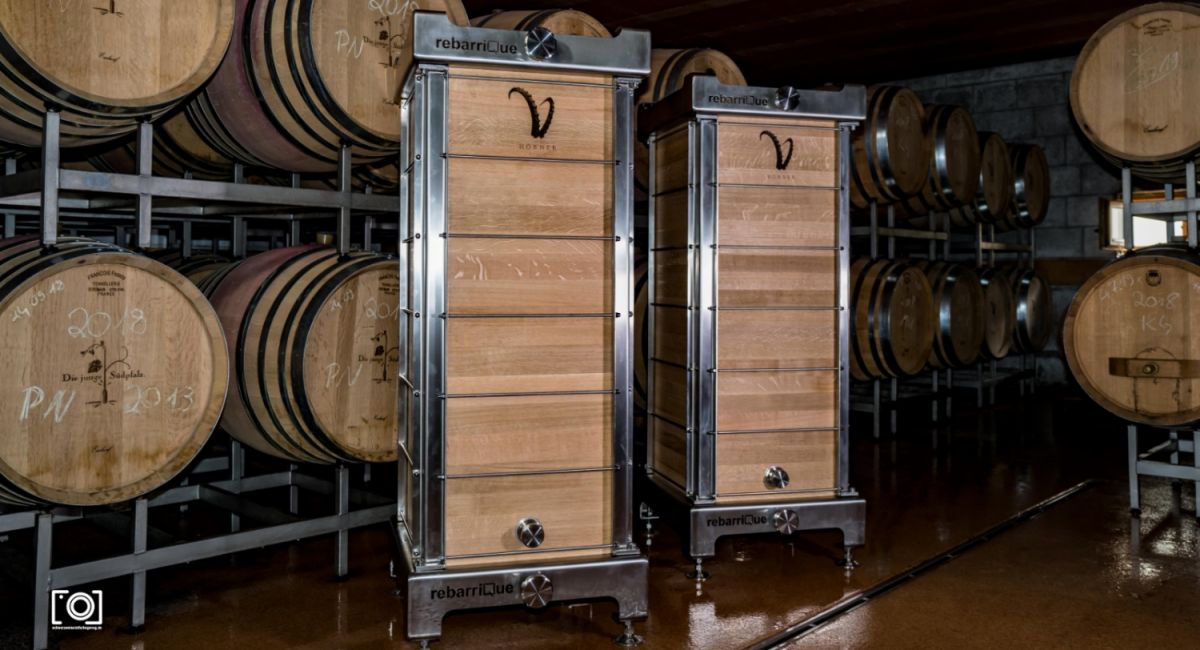A special system developed in Germany as an alternative to conventional barrique barrels for barrique maturing. It is produced in Hochstadt in der Pfalz by rebarriQue GmbH & CoKG. The basic idea is a dismountable, square "Barrique barrel", which can be renewed and toasted (Retoast) on the inside of the walls almost as often as desired. The barrel staves are considerably shorter and - with increasing number of retoasts - also thinner than conventional barrel staves. This results in an up to 90% lower consumption of oak wood for the production of barrel staves as well as a significantly lower consumption of space in the barrel stores of the winegrowers. The manufacturer argues with the advantage of sustainability and justifies this as follows: In conventional barrels, only 10 to 15% of the total wood mass is effectively used for the extraction of phenols and tannins for the ageing of wines, spirits and craft beer. Unfortunately, the entire rest of this wood mass (in the picture on the left, light yellow to ochre) often remains unused and pollutes the environment due to its energy-intensive harvesting, production and transport conditions.

Each rebarriQue (a single container) can be disassembled as often as required, entire drum wall sides or individual drum staves can be replaced, toasted and reassembled to be liquid-tight. The inner surfaces can be planed off, toasted again and covered with wine again. This is made possible by a detachable locking system between the individual staves as well as between the four sides of the barrel wall, which allows easy disassembly, chemical-free reworking and multiple reconditioning of the rebarriQues. This means that the four barrel walls can also be combined with different toasting profiles in one rebarriQue. Possible drum wall individual toasts (robot toasts) are: Heavy Toast (H) 25% Medium Toast (M) 15%, Soft Toast (S) 5%. The toasting profiles range from SSSS (Supersoft) 20% to HHHH (Four Times Heavy) 100%.
Digital profiles are assigned to these three toasting variants and are transferred to the barrel walls by a toasting robot. The following applies here: Toasting profile H corresponds to a toasting proportion of 25% of the total body. Medium toasts (M) contribute 15% of the total toast per barrel wall and soft toasts (S) contribute 5% per barrel wall. All toasting profiles are stored in the toasting robot and can be recalled at any time or reconfigured to meet customer requirements. For example, if a winemaker uses a Pinot Noir in the HMMS toasting variant for the first time on a rebarriQue, the toasting degree "Toast 1" is 60% (25+15+15+5). If the winemaker plans the first rebarriQue with the same wine from the following vintage and wishes to achieve a minimal increase in the toast aroma content, he chooses e.g. the toasting variant HHMS and thus increases the total toast to 70% without sacrificing the fruit aromas of the soft toasted barrel wall S (25+25+15+5).
In this way, 12 toasting profiles from "Supersoft" SSSS (toasting degree 20%) to "Four Times Heavy" HHHH (toasting degree 100%) can be reliably reproduced in 5% steps, vintage by vintage. In combination with the possibilities of individually determined reconditioning targets - a very high number of toasts stands for ambitious sustainability targets - a lower number of toasts stands for high quality standards, the use of rebarriQues offers completely new, previously unknown oenological fields of action. If the winemaker decides against retoasting his rebarriQues and chooses, for example, a rebarriQue "12" with an initial thickness of 12 millimeters, he still reduces the consumption of oak wood by more than 60 % compared to the use of conventional barriques. Added to this is the easier cascade use of the used but straight and therefore easier to continue to use rebarriQue staves as parquet flooring, kitchen worktops, small furniture, cutting boards, etc. A similar system developed in Australia is Stakvat. See also barrel and vinification.
Pictures: © rebarriQue
Voices of our members

wein.plus is a handy, efficient guide to a quick overview of the colourful world of wines, winegrowers and grape varieties. In Wine lexicon, the most comprehensive of its kind in the world, you will find around 26,000 keywords on the subject of grape varieties, wineries, wine-growing regions and much more.
Roman Horvath MW
Domäne Wachau (Wachau)